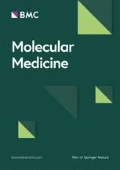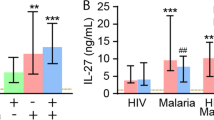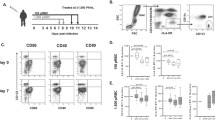Abstract
Molecular immunologic determinants of disease severity during Plasmodium falciparum malaria are largely undetermined. Our recent investigations showed that peripheral blood mononuclear cell (PBMC) cyclooxygenase-2 (COX-2) gene expression and plasma prostaglandin E2 (PGE2) production are suppressed in children with falciparum malaria relative to healthy, malaria-exposed children with partial immunity. Furthermore, decreased COX-2/PGE2 levels were significantly associated with increased plasma interleukin-10 (IL-10), an anti-inflammatory cytokine that inhibits the expression of COX-2 gene products. To determine the mechanism(s) responsible for COX-2-derived PGE2 suppression, PBMCs were cultured from children with falciparum malaria. PGE2 production was suppressed under baseline and COX-2-promoting conditions (stimulation with lipopolysaccharide [LPS] and interferon [IFN]-γ) over prolonged periods, suggesting that an in vivo-derived product(s) was responsible for reduced PGE2 biosynthesis. Ingestion of hemozoin (malarial pigment) by PBMC was investigated as a source of COX-2/PGE2 suppression in PBMCs from healthy, malaria-naive adults. In addition, synthetically prepared hemozoin, β-hematin, was used to investigate the effects of the core iron component of hemozoin, ferriprotoporphyrin-IX (FPIX). Physiologic concentrations of hemozoin or β-hematin suppressed LPS- and IFN-γ-induced COX-2 mRNA in a time- and dose-dependent manner, resulting in decreased COX-2 protein and PGE2 production. Suppression of COX-2/PGE2 by hemozoin was not due to decreased cell viability as evidenced by examination of mitochondrial bioactivity. These data illustrate that ingestion of FPIX by blood mononuclear cells is responsible for suppression of COX-2/PGE2. Although hemozoin induced overproduction of IL-10, neutralizing IL-10 antibodies failed to restore PGE2 production. Thus, acquisition of hemozoin by blood mononuclear cells is responsible for suppression of PGE2 in malaria through inhibition of de novo COX-2 transcripts via molecular mechanisms independent of increased IL-10 production.







Similar content being viewed by others
References
Vane J, Bakhle Y, Botting R. (1998) Cyclooxygenase 1 and 2. Ann. Rev. Pharmacol. Toxicol. 38:97–120.
Murakami M, Nakatani Y, Atsumi G, Inoue K, Kudo I. (1997) Regulatory functions of phospholipase A2. Crit. Rev. Immunol. 17:225–83.
Appleton I, Tomlinson A, Willoughby D. (1996) Induction of cyclooxygenase and nitric oxide synthase in inflammation. Adv. Pharmacol. 35:27–78.
Seibert K, Masferrer JL. (1994) Role of inducible cyclooxygenase (COX-2) in inflammation. Receptor 4:17–23.
Smith WL, Marnett LJ, DeWitt DL. (1991) Prostaglandin and thromboxane biosynthesis. Pharmacol. Ther. 49:153–79.
Perkins DJ, Kremsner PG, Weinberg JB. (2001) Inverse relationship of plasma prostaglandin E2 and blood mononuclear cell cyclooxygenase-2 with disease severity in children with Plasmodium falciparum malaria. J. Infect. Dis. 183:113–8.
Perkins DJ, Hittner JB, Mwaikambo ED, Granger DJ, Weinberg JB, Anstey NM. (2004) Impaired systemic prostaglandin E2 production in children with cerebral malaria. J. Infect. Dis. In press.
Francis SE, Sullivan DJ, Jr., Goldberg DE. (1997) Hemoglobin metabolism in the malaria parasite Plasmodium falciparum. Annu. Rev. Microbiol. 51:97–123.
Goldie P, Roth Jr E, Oppenheim J, Vanderberg J. (1990) Biochemical characterization of Plasmodium falciparum hemozoin. Am. J. Trop. Med. Hyg. 43:584–96.
Schwarzer E, Alessio M, Ulliers D, Arese P. (1998) Phagocytosis of the malarial pigment, hemozoin, impairs expression of major histocompatibility complex class II antigen, CD54, and CD11c in human monocytes. Infect. Immun. 66:1601–6.
Arese P, Schwarzer E. (1997) Malarial pigment (haemozoin): A very active ‘inert’ substance. Ann. Trop. Med. Parasitol. 91:501–16.
Pichyangkul S, Saengkrai P, Webster H. (1994) Plasmodium falciparum pigment induces monocytes to release high levels of tumor necrosis factor-a and interleukin-1 β. Am. J. Trop. Med. Hyg. 51:430–5.
Mordmuller B, Turrini F, Long H, Kremsner P, Arese P. (1998) Neutrophils and monocytes from subjects with the Mediterranean G6PD variant: Effect of Plasmodium falciparum hemozoin on G6PD activity, oxidative burst and cytokine production. Eur. Cytokine Netw. 9:2339–246.
Perkins DJ, Kniss D. (1997) Tumor necrosis factor-α promotes sustained cyclooxygenase-2 expression: Attenuation by dexamethasone and NSAIDs. Prostaglandins 54:727–43.
Niiro H et al. (1995) Inhibition by interleukin-10 of inducible cyclooxygenase expression in lipopolysaccharide-stimulated monocytes: its underlying mechanism in comparison with interleukin-4. Blood 85:3736–45.
Schwarzer E, Turrini F, Giribaldi G, Cappadoro M, Arese P. (1993) Phagocytosis of P. falciparum malarial pigment hemozoin by human monocytes inactivates monocyte protein kinase C. Biochim. Biophys. Acta. 1181:51–4.
Fiori PL et al. (1993) Reduced microbicidal and anti-tumor activities of human monocytes after ingestion of Plasmodium falciparum-infected red blood cells. Parasite Immunol. 15:647–55.
Schwarzer E et al. (1992) Impairment of macrophage functions after ingestion of Plasmodium falciparum-infected erythrocytes or isolated malarial pigment. J. Exp. Med. 176:1033–41.
Keller CC et al. (2004) Elevated nitric oxide production in children with malarial anemia: Hemozoin-induced nitric oxide synthase type 2 transcripts and nitric oxide in blood mononuclear cells. Infect. Immun. 72:4868–73.
Kun J et al. (1998) Merozoite surface antigen 1 and 2 genotypes and rosetting of Plasmodium falciparum in severe and mild malaria in Lambaréné, Gabon. Trans. R. Soc. Trop. Med. Hyg. 92:110–4.
Perkins DJ, Weinberg JB, Kremsner PG. (2000) Reduced interleukin-12 and transforming growth factor-β1 in severe childhood malaria: Relationship of cytokine balance with disease severity. J. Infect. Dis. 182:988–92.
Weinberg JB, Muscato JJ, Niedel JE. (1981) Monocyte chemotactic peptide receptor. Functional characteristics and ligand-induced regulation. J. Clin. Invest. 68:621–30.
Egan TJ, Mavuso WW, Ncokazi KK. (2001) The mechanism of beta-hematin formation in acetate solution. Parallels between hemozoin formation and biomineralization processes. Biochemistry 40:204–13.
Perkins DJ et al. (2003) In vivo acquisition of hemozoin by placental blood mononuclear cells suppresses PGE2, TNF-a, and IL-10. Biochem. Biophys. Res. Comm. 311:839–46.
Perkins DJ, Kniss DA. (1997) Rapid and transient induction of cyclooxygenase 2 by epidermal growth factor in human amnion-derived WISH cells. Biochem. J. 321:677–81.
Chomczynski P, Sacchi N. (1987) Single-step method of RNA isolation by acid guanidinium thiocyanate-phenol-chloroform extraction. Anal. Biochem. 162: 156–9.
Sales KJ et al. (2001) Cyclooxygenase-2 expression and prostaglandin E(2) synthesis are up-regulated in carcinomas of the cervix: a possible autocrine/paracrine regulation of neoplastic cell function via EP2/EP4 receptors. J. Clin. Endocrinol. Metab. 86:2243–9.
Day NP et al. (1996) Clearance kinetics of parasites and pigment-containing leukocytes in severe malaria. Blood 88:4694–700.
Olliaro P et al. (2000) Phagocytosis of hemozoin (native and synthetic malaria pigment), and Plasmodium falciparum intraerythrocyte-stage parasites by human and mouse phagocytes. Ultrastruct. Pathol. 24:9–13.
Schwarzer E, Bellomo G, Giribaldi G, Ulliers D, Arese P. (2001) Phagocytosis of malarial pigment haemozoin by human monocytes: a confocal microscopy study. Parasitology 123:125–31.
Slater AF et al. (1991) An iron-carboxylate bond links the heme units of malaria pigment. Proc. Natl. Acad. Sci. U.S.A. 88:325–9.
Pagola S, Stephens PW, Bohle DS, Kosar AD, Madsen SK. (2000) The structure of malaria pigment beta-haematin. Nature 404:307–10.
Deininger MH, Kremsner PG, Meyermann R, Schluesener HJ. (2000) Focal accumulation of cyclooxygenase-1 (COX-1) and COX-2 expressing cells in cerebral malaria. J. Neuroimmunol. 106:198–205.
Ball HJ, MacDougall HG, McGregor IS, Hunt NH. (2004) Cyclooxygenase-2 in the pathogenesis of murine cerebral malaria. J. Infect. Dis. 189:751–8.
Mifflin RC et al. (2002) Regulation of COX-2 expression in human intestinal myofibroblasts: mechanisms of IL-1-mediated induction. Am. J. Physiol. Cell Physiol. 282:C824–34.
Lin CH et al. (2000) Involvement of protein kinase C-gamma in IL-1β-induced cyclooxygenase-2 expression in human pulmonary epithelial cells. Mol. Pharmacol. 57:36–43.
Dupuis F, Gachard N, Allegraud A, Praloran V, Denizot Y. (1998) Prostaglandin E2 stimulates the growth of human blood CD34+ progenitors. Prostaglandins Other Lipid Mediat. 55:179–86.
Phipps RP, Stein SH, Roper RL. (1991) A new view of prostaglandin E regulation of the immune response. Immunol. Today 12:349–52.
Kunkel SL et al. (1988) Prostaglandin E2 regulates macrophage-derived tumor necrosis factor gene expression. J. Biol. Chem. 263:5380–4.
Choi SS, Gatanaga M, Granger GA, Gatanaga T. (1996) Prostaglandin E2 regulation of tumor necrosis factor receptor release in human monocytic THP-1 cells. Cell Immunol. 170:178–84.
Riley EM, MacLennan C, Wiatkowski DK, Greenwood BM. (1989) Suppression of in vitro lymphoproliferative responses in acute malaria patients can be partially reversed by indomethacin. Parasite Immunol. 11:509–17.
Alves MF, Santos-Neto LL, Junqueira MI, Tosta CE, Costa CE. (1992) Cytokines and dysregulation of the immune response in human malaria. Mem. Inst. Oswaldo Cruz 87 Suppl 3:331–6.
Tegeder I, Pfeilschifter J, Geisslinger G. (2001) Cyclooxygenase-independent actions of cyclooxygenase inhibitors. FASEB J. 15:2057–72.
Acknowledgments
We thank the staff members of the Albert Schweitzer Hospital in Lambaréné, Gabon, for their cooperation and technical assistance: Anita van den Biggelaar, Judith Jans, Hanna Knoop, Doris Luckner Barbara Moritz, Anselme Ndzengue, Marcel Nkeyi, Daniela Schmid, and Milena Sovric. Furthermore, we would like to thank Dr. Venkatachalam Udhayakumar for his scientific input.
This work was conducted at the University of Pittsburgh and was supported in part by the National Institutes of Health Grants AI-51305-01 (DJP) and AI-41764 (JBW), the VA Research Service (JBW), and the University of Pittsburgh Competitive Research Development Fund (DJP). Portions of this work were presented at The 51st Annual Meeting of the American Society of Tropical Medicine and Hygiene in Denver, CO, in November 2002. The title of the presentation was Cyclooxygenase-2 and Prostaglandin E2 Down-regulation by Hemozoin is Associated with Overproduction of TNF-α Implications for the Pathogenesis of Severe Malaria (abstract number 74).
The study was approved by the ethics committee of the International Foundation of the Albert Schweitzer Hospital, Duke University Medical Center Investigational Review Board, and the University of Pittsburgh Investigational Review Board, and informed consent was obtained from the participants or the parents of participating children.
There is no conflict of interest for any of the authors of the manuscript due to commercial or other affiliations.
Author information
Authors and Affiliations
Corresponding author
Rights and permissions
About this article
Cite this article
Keller, C.C., Hittner, J.B., Nti, B.K. et al. Reduced Peripheral PGE2 Biosynthesis in Plasmodium falciparum Malaria Occurs through Hemozoin-Induced Suppression of Blood Mononuclear Cell Cyclooxygenase-2 Gene Expression via an Interleukin-10-Independent Mechanism. Mol Med 10, 45–54 (2004). https://doi.org/10.2119/2004-00035.Perkins
Received:
Accepted:
Published:
Issue Date:
DOI: https://doi.org/10.2119/2004-00035.Perkins




